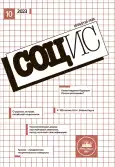Migration of the Population in the Border Region: Status and Trends (the Case of the Saratov Region)
- 作者: Loginova L.V.1, Shcheblanova V.V.1
-
隶属关系:
- Saratov State Law Academy
- 期: 编号 10 (2023)
- 页面: 52-64
- 栏目: Articles
- URL: https://journals.rcsi.science/0132-1625/article/view/251499
- DOI: https://doi.org/10.31857/S013216250028304-7
- ID: 251499
全文:
详细
作者简介
Larisa Loginova
Saratov State Law Academy
ORCID iD: 0000-0003-2675-2801
Russian Federation, Saratov
Veronika Shcheblanova
Saratov State Law AcademyRussian Federation, Saratov
参考
- Бийжанова Э.К. Социальная политика региональной власти: развитие социокультурного потенциала приграничья // Ученые записки КФУ им. В. И. Вернадского. Социология. Педагогика. Психология. 2018. Т. 4 (70). № 4. C. 3–9.
- Дорошенко С.В. Компаративный анализ малого предпринимательства в приграничных регионах России и Казахстана // Экономика региона. 2020. Т. 16. Вып. 3. С. 712–724. doi: 10.17059/ekon.reg.2020-3-3.
- Карпенко М.С., Колосов В.А., Себенцов А. Б. Трансформация российско-казахстанского пограничья в постсоветский период: институциональное и экономическое измерения // Проблемы национальной стратегии. 2021. № 5(68). С. 25–40. doi: 10.52311/2079-3359_2021_5_25.
- Карцева М.А., Мкртчян Н.В., Флоринская Ю.Ф. Миграция в России и социально-экономическое развитие регионов: анализ взаимного влияния // Проблемы прогнозирования. 2020. № 4. С. 87–97.
- Колосов В.А., Вендина О.И., Зотова М.В. и др. Российское пограничье: вызовы соседства / Под ред. В.А. Колосова. М.: ИП Матушкина И.И., 2018.
- Красинец Е.С. Международная трудовая миграция в развитии современной России // Народонаселение. 2022. Т. 25. № 2. С. 104–115. doi: 10.19181/population.2022.25.2.9.
- Логинова Л.В. Миграция сельского населения в современных условиях: состояние, особенности и последствия // Аграрная наука и образование: проблемы и перспективы. Саратов: ЦАИ СГАУ, 2022. С. 239–245.
- Олейник С.А. Особенности государственной политики интеграции иммигрантов в приграничных регионах // Власть. 2021. Т. 29. № 3. С. 71–76. doi: 10.31171/vlast.v29i3.8142.
- Пипия Л.К., Чистякова В.Е. Проблема «утечки умов» на фоне миграционных процессов в России // Инновации. 2020. № 8 (262). С. 18–19. doi: 10.26310/2071-3010.2020.262.8.003.
- Попкова Л.И. Теория и практика приграничных исследований // Геополитика и экогеодинамика регионов. 2019. Т. 5 (15). Вып. 1. C. 243–249.
- Реутов Е.В. Отток населения как угроза российской провинции // Большая Евразия: Развитие, безопасность, сотрудничество. 2020. № 3-1. С. 809–812.
- Рычихина Н.С. Современные тенденции женской международной трудовой миграции // Женщина в российском обществе. 2020. №. 1. С. 45–54. doi: 10.21064/WinRS.2020.1.4.
- Рязанцев С.В., Вазиров З.К., Гарибова Ф.М. «Зависшие на границах» между Россией и Родиной: мигранты из стран Центральной Азии во время пандемии СOVID-19 // Научное обозрение. Сер. 1. Экономика и право. 2020. № 3. С. 45–58. doi: 10.26653/2076-4650-2020-3-04.
- Рязанцев С.В., Ростовская Т.К., Перемышлин С.Н. Гендерные аспекты трудовой миграции в России: тренды, последствия, регулирование // Женщина в российском обществе. 2019. № 4. С. 53–65. doi: 10.21064/WinRS.2019.4.5.
- Сивоплясова С.Ю. Региональные различия женской эмиграции из приграничных территорий России // Региональные проблемы. 2017. Т. 20. № 3. С. 58–62.
- Яськова Т.И. Межстоличное положение как вызов социально-экономическому развитию российско-белорусского приграничья // Региональные исследования. 2021. № 2. С. 74–85. doi: 10.5922/1994-5280-2021-2-7. doi: 10.5922/1994-5280-2021-2-7.
- Chudinovskikh O., Kharaeva O. Migration policy towards skilled labor in the Russian Federation // BRICS Journal of Economics, 2020. No. 1(2). С. 80–102. doi: 10.38050/2712-7508-2020-11.









